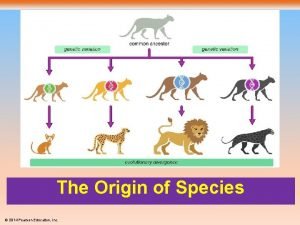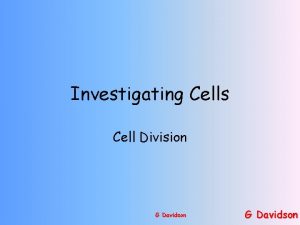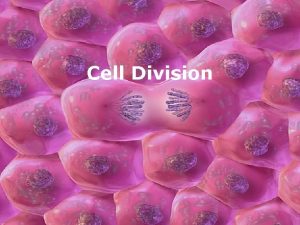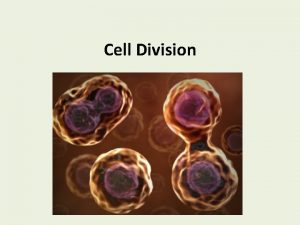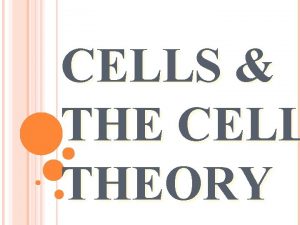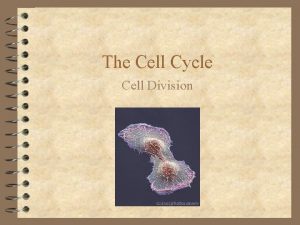Cell Division Overview Cell Division New cells arise





















- Slides: 21

Cell Division

Overview: Cell Division: New cells arise from the division of pre-existing cells – Most cell division results in daughter cells with identical genetic information, DNA – Integral part of the cell cycle, the life of a cell from formation to its own division • Three types of cell division: – Binary fission (observed in asexually reproducing organisms) – Mitosis (refer to next slide) – Meiosis (observed in sexually reproducing organisms)

Mitosis is seen in: A. Unicellular (definition: one –cell) organism – Reproduction of an entire organism B. Multicellular (definition: more than one/multiple cell) organisms – Development from a fertilized cell – Growth – Repair 100 µm (a) Reproduction 20 µm 200 µm (b) Growth and development (c) Tissue renewal

Mitosis and the Cell cycle • Interphase – G 1: growth phase, making cell organelles – S phase: DNA synthesis (replication) – G 2 phase: preparation for cell division, mitosis and cytokinesis • Mitotic phase: creates two identical daughter cells – Mitosis: Division of the nucleus – Cytokinesis: Division of the cytoplasm

Cellular Organization of the Genetic Material IN EUKARYOTES…. . Chromatin: -complex of DNA and associated proteins (histones) -Condenses during the cell division

chromosomes VERSUS chromatid During DNA synthesis, one chromosome duplicates to result in two sister chromatids During cell division, the two sister chromatids separate into two daughter cells The centromere is the narrow “waist” of the duplicated chromosome, where the two chromatids are most closely attached

Cellular Organization of the Genetic Material – In prokaryotes (example: bacteria): One chromosome made of a single circular molecule of DNA (a plasmid). – In eukaryotes (example: humans): Variable number of chromosomes (characteristic of species) made of molecules of long linear DNA. • Example: humans have 46 chromosomes

Types of cell division • Eukaryotic cells: Two types of cell division for Two types of cells 1. Mitosis occurs in somatic cells (body cells) -Mitosis results in genetically identical cells 2. Meiosis occurs in reproductive cells called gametes (eggs and sperm) -Meiosis is a way to combine genetic traits during reproduction • Prokaryotic cells: Binary fission

MITOSIS • Mitosis is conventionally divided into the phases (P-M-A-T): – Prophase – Metaphase – Anaphase – Telophase • Cytokinesis is well underway by late telophase • NOTE: In some textbooks, interphase is considered part of mitosis…. hence in that case it is IPMAT

MITOSIS

Cytokinesis – Formation of cleavage furrow – Contractile ring made of microfilaments (actin) associated with myosin – Accumulation of vesicles from Golgi apparatus, carrying cell wall materials. → Cell plate – Use a network of microtubules (tubulin) to align vesicles

Does mitosis occur in all cells? No… -Sex cells (gametes) do not undergo mitosis Why? -reproduction involves the combining of traits from two organisms - cannot combine/fuse any two random cells

Sexual Reproduction • Meiosis = specialized cell division so you have only one of each chromosome, called • Gametes: made only in gonad (testis, ovary) n (23) + 2 n = 46 n (23)

Why cannot we have mitosis for sex cells (gametes)? • Sex cells (gametes) allow traits to be combined from two organisms. • Can’t just fuse any two random cells. A 1 B 35 A 2 B 44 2 n (46) + 2 n (46) A 3 B 41 A 26 B 35 4 n = 92 too many 14

Chromosome numbers • Diploid: possess two sets of each chromosome; one from the father and one from the mother. • Human: 46 chromosomes or 23 pairs of homologous chromosomes (2 sets; 2 n). • In somatic cells, during the cell cycle: – 46 chromosomes are duplicated during the S phase – Each daughter cell receives an identical copy of each of the 46 chromosomes. • Gametes, obtained via meiosis, are haploid – Yield non-identical cells containing 23 chromosomes (1 set; n) – Fusion of two gametes (fertilization) returns the number of chromosomes to 46.

Mitosis versus Meiosis MITOSIS MEIOSIS Diploid somatic cell Diploid gamete precursor duplication division Diploid Haploid division Meiosis has 2 divisions: Meiosis I and Meiosis II 16

The Cell Cycle Control System • The sequential events of the cell cycle are directed by a distinct cell cycle control system, which is similar to a clock • The cell cycle control system is regulated by both internal and external controls • The clock has specific checkpoints where the cell cycle stops until a go-ahead signal is received – Monitor integrity of genome – Prevent the cell from progressing through the cell cycle if abnormalities are detected – Correct size – Type and amount of specific proteins


• For many cells, the G 1 checkpoint seems to be the most important one • If a cell receives a go-ahead signal at the G 1 checkpoint, it will usually complete the S, G 2, and M phases and divide • If the cell does not receive the go-ahead signal, it will exit the cycle, switching into a nondividing state called the G 0 phase

Loss of Cell Cycle Controls in Cancer Cells • Cancer cells – Do not respond normally to the body’s control mechanisms – Exhibit neither density-dependent inhibition nor anchorage dependence – May not need external growth factors to grow and divide: • They make their own growth factor • They may convey a growth factor’s signal without the presence of the growth factor • They may have an abnormal cell cycle control system

Development of cancer • Transformation: a normal cell is converted to cancer cell in a tissue; normally degraded by immune system. • Tumor: mass of abnormal cells within a tissue – Benign tumor: abnormal cells remain in the tissue – Malignant tumor: abnormal cells; become invasive; impair the function of one or more organs → Cancer • Metastasis: spreading of cancer cells to location(s) distant from original site where they may proliferate and create secondary tumors. • Through fluids such as blood and lymph
 Describe the conditions under which new species may arise.
Describe the conditions under which new species may arise. Development of paranasal sinuses
Development of paranasal sinuses Tubular reabsorption
Tubular reabsorption Parafollicular cells vs follicular cells
Parafollicular cells vs follicular cells Haploid and diploid venn diagram
Haploid and diploid venn diagram Why dna is more stable than rna?
Why dna is more stable than rna? Red blood cells and white blood cells difference
Red blood cells and white blood cells difference Eukaryotic life
Eukaryotic life Plant vs animal cells venn diagram
Plant vs animal cells venn diagram Prokaryotic cells vs eukaryotic cells venn diagram
Prokaryotic cells vs eukaryotic cells venn diagram The organelle trail
The organelle trail Masses of cells form and steal nutrients from healthy cells
Masses of cells form and steal nutrients from healthy cells Younger cells cuboidal older cells flattened
Younger cells cuboidal older cells flattened What cell type
What cell type Are red blood cells prokaryotic or eukaryotic
Are red blood cells prokaryotic or eukaryotic Nondisjunction in meiosis
Nondisjunction in meiosis Cell substance
Cell substance Section 10-2 cell division
Section 10-2 cell division Cell cycle and cell division
Cell cycle and cell division Steps of cell cycle
Steps of cell cycle The call to arise and shine
The call to arise and shine How did the ottoman safavid and mughal empires arise
How did the ottoman safavid and mughal empires arise
